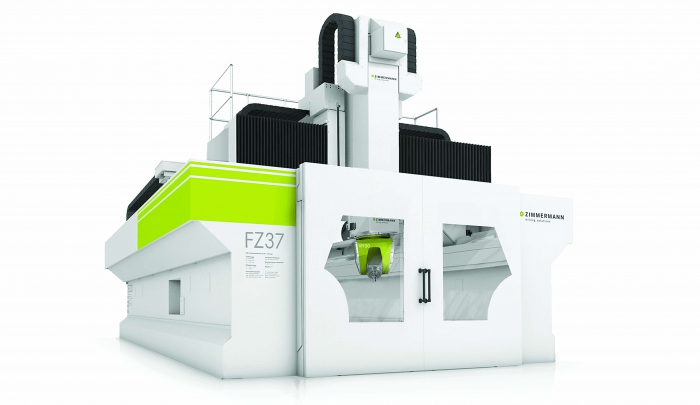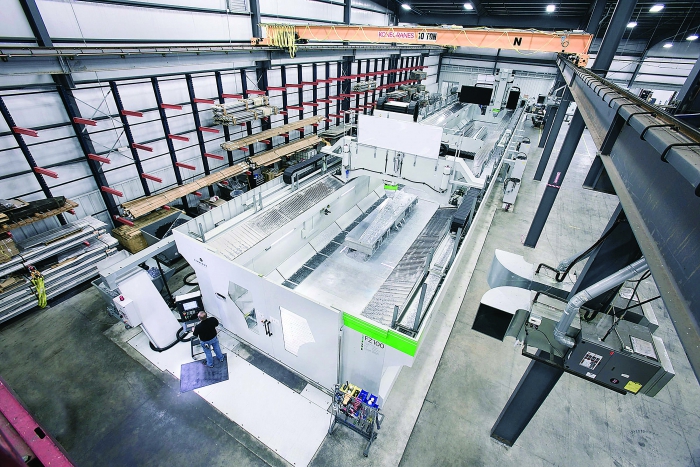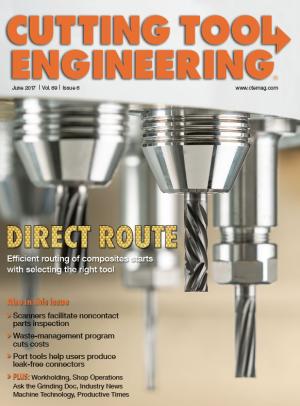It’s safe to say that most people would call a 20'-long (6.1m), 65-ton milling machine “big.” Such a machine was recently installed at the Connecticut Center for Advanced Technology (CCAT), East Hartford, Conn. But those working for machine tool builder Zimmermann may not describe it that way.
The CCAT machine “is not the largest we have. In fact, it’s one of our smallest,” said Yves Klein, sales and project manager for Zimmermann Inc., Wixom, Mich., the U.S. arm of Neuhausen, Germany-headquartered Zimmermann GmbH.
As you may have guessed, Zimmermann specializes in very large machine tool installations. The company offers milling machines with working ranges from 2.5m to 30m (8.2' to 98.4') along the X-axis and from 3m to 6m (9.8' to 19.7') along the Y-axis.

Recently installed at a Connecticut site, a customized version of Zimmermann’s FZ37 milling machine offers travel distances of 3m (9.84') along the X and Y axes. Image courtesy of Zimmermann.
Why go big when choosing a machine tool? For one, extra-large machines allow 5-axis machining of large parts. They also enhance stability and stiffness during machining.
In addition, Zimmermann machines are large enough to allow two separate operations in different areas. “Customers may have a 20m machine with a partition wall that basically gives them two work areas,” Klein said. They can machine a part in one work area and perform secondary operations in another, partitioned-off area. Similarly, they can machine a steel part in one area and an aluminum part in the other. Once the separate tasks are completed, users can remove the partition and create one large work area for subsequent operations, such as assembly.
But why not opt for two smaller machines to perform different tasks rather than one behemoth? According to Klein, it’s actually cheaper to purchase a 10m-long (32.8')machine than it would be to buy two 5m (16.4') machines.
On the other hand, extending the length of a machine tool adversely impacts machining accuracy. “A 25m machine is still accurate, but a 5m machine has more accuracy,” Klein noted.
After a machine is purchased, it is assembled in Germany and the customer travels there to inspect and sign off on the unit. The machine is then disassembled and shipped in pieces to the customer’s site, where Zimmermann technicians reassemble and install it. Before this stage of the process, Zimmermann presents the customer with a technical-layout plan that covers everything necessary for installation, including requirements for the floor and machine foundation.

It took 6 months to install a huge Zimmermann FZ100 milling machine at a facility in Wichita, Kan. Image courtesy of Zimmermann.
The Zimmermann machine installed at CCAT is a customized version of the company’s FZ37 5-axis milling machine, which offers travel distances of 3m (9.8') along the X and Y axes, and 1.5m (4.9') along the Z-axis. Installation of the machine started in January and concluded in April. Connecticut manufacturers will use the $1.9-million unit for high-speed machining of composite materials. Its first project: machining fan cases for the F-35 Lightning II F135 engine.
Last year, a much bigger version of the FZ37 was installed in Canada for a customer that manufactures large metal components. Weighing 187 tons, the $2-million machine is 20m (65.6') long × 7.5m (24.6') wide × 6.65m (21.8') high.
Zimmermann’s largest U.S. installation (and probably the largest in the world, according to Klein) turns out aerospace parts in Wichita, Kan. Weighing more than 290 tons, the FZ100 milling machine has a working range of 25m (82.0') along the X-axis and is 37m (121.4') long. Klein refers to this unit as a “6-axis machine,” offering the normal three linear axes and special 3-axis milling heads. Installed over a 6-month period in 2013 and costing roughly $4.5 million, the massive machine also features a partition wall that creates two 12.5m-long (41.0') work areas, each with its own portal and milling head.
Besides North American manufacturers, Zimmermann works with organizations around the world that “think big” when it comes to milling machines.
Related Glossary Terms
- gang cutting ( milling)
gang cutting ( milling)
Machining with several cutters mounted on a single arbor, generally for simultaneous cutting.
- milling
milling
Machining operation in which metal or other material is removed by applying power to a rotating cutter. In vertical milling, the cutting tool is mounted vertically on the spindle. In horizontal milling, the cutting tool is mounted horizontally, either directly on the spindle or on an arbor. Horizontal milling is further broken down into conventional milling, where the cutter rotates opposite the direction of feed, or “up” into the workpiece; and climb milling, where the cutter rotates in the direction of feed, or “down” into the workpiece. Milling operations include plane or surface milling, endmilling, facemilling, angle milling, form milling and profiling.
- milling machine ( mill)
milling machine ( mill)
Runs endmills and arbor-mounted milling cutters. Features include a head with a spindle that drives the cutters; a column, knee and table that provide motion in the three Cartesian axes; and a base that supports the components and houses the cutting-fluid pump and reservoir. The work is mounted on the table and fed into the rotating cutter or endmill to accomplish the milling steps; vertical milling machines also feed endmills into the work by means of a spindle-mounted quill. Models range from small manual machines to big bed-type and duplex mills. All take one of three basic forms: vertical, horizontal or convertible horizontal/vertical. Vertical machines may be knee-type (the table is mounted on a knee that can be elevated) or bed-type (the table is securely supported and only moves horizontally). In general, horizontal machines are bigger and more powerful, while vertical machines are lighter but more versatile and easier to set up and operate.
- stiffness
stiffness
1. Ability of a material or part to resist elastic deflection. 2. The rate of stress with respect to strain; the greater the stress required to produce a given strain, the stiffer the material is said to be. See dynamic stiffness; static stiffness.


